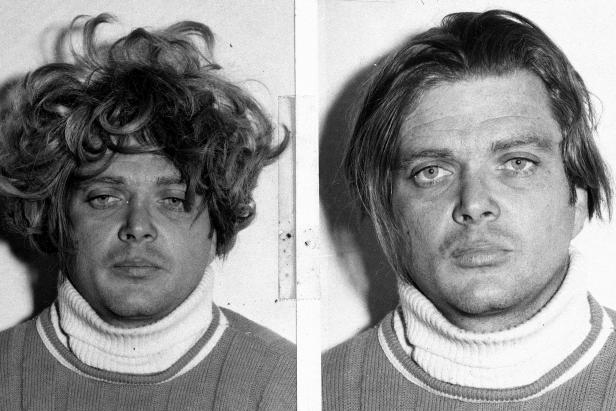Man Called 'The Pied Piper Of Tucson' Kills 3, Buries Them In The Desert
Charles Schmid — who cannot be dismissed as a freak, an aberrant of no consequence — had for years functioned successfully as a member, even a leader, of the yeastiest stratum of Tucson’s teen-age society.

Charles Schmid is shown with and without the wig he had on when captured after escaping from the penitentiary, Nov. 14, 1972. (AP Photo)
The Pied Piper of Tucson
Originally published in Life Magazine by Don Moser on March 4, 1966.
"Hey, c’mon babe, follow me / I’m the Pied Piper, follow me / I’m the Pied Piper, and I’ll show you where it’s at."
— Popular song, Tucson, winter 1963
At dusk in Tucson, as the stark, yellow-flared mountains begin to blur against the sky, the golden car slowly cruises Speedway. Smoothly it rolls down the long divided avenue, past the supermarkets, the gas stations and the motels; past the twist joints, the sprawling drive-in restaurants. The car slows for an intersection, stops, then pulls away again. The exhaust mutters against the pavement as the young man driving takes the machine swiftly, expertly through the gears. A car pulls even with him; the teen-age girls in the front seat laugh, wave and call his name. The young man glances toward the rearview mirror, turned always so he can look at his own reflection, and he appraises himself.
The face is his own creation; the hair dyed raven black, the skin darkened to a deep tan with pancake make-up, the lips whitened, the whole effect heightened by a mole he has painted on one cheek. But the deep-set blue eyes are all his own. Beautiful eyes, the girls say.
Approaching the Hi-Ho, the teen-agers’ nightclub, he backs off on the accelerator, then slowly cruises on past Johnie’s Drive-in. The cars are beginning to orbit and accumulate in the parking lot — near sharp cars with deep-throated mufflers and Maltese-cross decals on the windows. But it’s early yet. Not much going on. The driver shifts up again through the gears, and the golden car slides away along the glitter and gimcrack of Speedway. Smitty keeps looking for the action.
Whether the juries in the two trials decide that Charles Howard Schmid Jr. did or did not brutally murder Alleen Rowe, Gretchen Fritz, and Wendy Fritz has from the beginning seemed of almost secondary importance to the people of Tucson. They are not indifferent. But what disturbs them far beyond the question of Smitty’s guilt or innocence are the revelations about Tucson itself that have followed on the disclosure of the crimes.
Starting from the bizarre circumstances of the killings and on through the ugly fragments of the plot — which in turn hint at other murders as yet undiscovered, at teen-age sex, blackmail, even connections with the Cosa Nostra — they have had to view their city in a new and unpleasant light. The fact is that Charles Schmid — who cannot be dismissed as a freak, an aberrant of no consequence — had for years functioned successfully as a member, even a leader, of the yeastiest stratum of Tucson’s teen-age society.
As a high school student Smitty had been, as classmates remember, an outsider — but not that far outside. He was small but he was a fine athlete, and in his last year — 1960 — he was a state gymnastics champion. His grades were poor, but he was in no trouble to speak of until his senior year, when he was suspended for stealing tools from a welding class.
But Smitty never really left the school. After his suspension he hung around waiting to pick up kids in a succession of sharp cars which he drove fast and well. He haunted all the teen-age hangouts along Speedway, including the bowling alleys and the public swimming pool — and he put on spectacular driving exhibitions for girls far younger than he.
At the time of his arrest last November, Charles Schmid was 23 years old. He wore face make-up and dyed his hair. He habitually stuffed three or four inches of old rags and tin cans into the bottoms of his high-topped boots to make himself taller than his five-foot-three, and stumbled about so awkwardly while walking that some people thought he had wooden feet.
He pursed his lips and let his eyelids droop in order to emulate his idol, Elvis Presley. He bragged to girls that he knew 100 ways to make love, and that he ran dope, that he was a Hell’s Angel. He talked about being a rough customer in a fight (he was, though he was rarely in one), and he always carried in his pocket tint bottles of salt and pepper, which he said he used to blind his opponents. He liked to use highfalutin language and had a favorite saying, “I can manifest my neurotical emotions, emancipate an epicureal instinct, and elaborate on my heterosexual tendencies.”
He occasionally shocked even those who thought they knew him well. A friend says that he once saw Smitty tie a string to the tail of his pet cat, swing it around his head and beat it bloody against a wall. Then he turned calmly and asked, “You feel compassion — why?”
Yet even while Smitty tried to create an exalted, heroic image of himself, he had worked on a pitiable one. “He thrived on feeling sorry for himself,” recalls a friend, “and making others feel sorry for him.” At various times, Smitty told inmates that he had leukemia and didn’t have long to live. He claimed that he was adopted, that his real name was Angel Rodriguez, that his father was a “bean” (local slang for Mexican, an inferior race in Smitty’s view), and that his mother was a famous lawyer who would have nothing to do with him.
What made Smitty a hero to Tucson’s youth?
Isn’t Tucson — out there in the Golden West, in the grand setting where the skies are not cloudy all day — supposed to be a flowering of the American Dream? One envisions teen-agers who drink milk, wear crewcuts, go to bed at half past 9, say “Sir” and “Ma’am” and like to go fishing with Dad. Part of Tucson is like this — but the city is not yet Utopia. It is glass and chrome and well-weathered stucco; it is also gimcrack, ersatz, and urban sprawl at its worst. Its suburbs stretch for mile after mile — a level sea of bungalows, broken only by mammoth shopping centers, that ultimately peters out among the cholla and saguaro. The city has grown from 85,000 to 300,000 since World War II. Few who live there were born there, and a lot are just passing through. Its superb climate attracts the old and the infirm, many of whom, as one citizen put it, “have come here to retire from their responsibilities to life.” Jobs are hard to find and there is little industry to stabilize employment. (“What do people do in Tucson?” the visitor asks. Answer: “They do each other’s laundry.”)
As for the youngsters, they must compete with the army of semi-retired who are willing to take on part-time work for the minimum wage. Schools are beautiful but overcrowded; and at those with split sessions, the kids are on the loose from noon on, or from 6 P.M. till noon the next day. When they get into trouble, Tucson teenagers are capable of getting into trouble in style: a couple of years ago they shocked the city fathers by throwing a series of beer-drinking parties in the desert, attended by scores of kids. The fests were called “boondockers” and if they were no more sinful than any other kid’s drinking parties, they were at least on a magnificent scale. One statistic seems relevant: 50 runaways are reported to the Tucson police department each month.
Of an evening, kids have nothing to do and wind up on Speedway, looking for action. There is the teen-age nightclub (“Pickup Palace,” the kids call it). There are the rock’n’roll beer joints (the owners check ages meticulously, but young girls can enter if they don’t drink; besides, anyone can buy a phony I.D. card for $2.50 around the high schools) where they can Jerk, Swim, and Frug away the evening to the room-shaking electronic blare of "Hang on Sloopy," "The Pied Piper," and a number called "The Bo Diddley Rock." At the drive-in hamburger and pizza stands, their cars circle endlessly, mufflers rumbling, as they check each other over.
Here on Speedway, you find Ritchie and Ronny, out of work and bored and with nothing to do. Here you find Debby and Jabron, from the wrong side of the tracks, aimlessly cruising in their battered old car looking for something — anything – to relieve the tedium of their lives, looking for somebody neat. (“Well, if the boys look bitchin’ you pull up next to them in your car and you roll down the window and say ‘Hey, how about a dollar for gas?' and if they give you the dollar, then maybe you let them take you to Johnie’s for a coke.”) Here you find Gretchen, pretty and rich and with problems, bad problems. Of a Saturday night, all of them cruising the long, bright street that seems endlessly in motion with the young. Smitty’s people.
He had a nice car. He had plenty of money from his parents, who ran a nursing home, and he was always glad to spend it on anyone who’d listen to him. He had a pad of his own where he threw parties, and he had impeccable manners. He was always willing to help a friend, and he would send flowers to girls who were ill. He was older and more mature than most of his friends. He knew where the action was, and if he wore make-up — well, at least he was different.
Some of the older kids — those who worked, who had something else to do — thought Smitty was a creep. But to the youngsters — to the bored and the lonely, to the dropout and the delinquent, to the young girls with beehive hairdos and tight pants they didn’t quite fill out, and to the boys with acne and no jobs — to these people, Smitty was a kind of folk hero. Nutty maybe, but at least more dramatic, more theatrical, more interesting than anyone else in their lives: a semi-ludicrous, sexy-eyed pied piper who, stumbling along in his rag-stuffed boots, led them up and down Speedway.
On the evening of May 31, 1964, Alleen Rowe prepared to go to bad early. She had to be in class by 6 A.M., and she had an examination the next day. Alleen was a pretty girl of 15, a better-than-average student who talked about going to college and becoming an oceanographer. She was also a sensitive child — given to reading romantic novels and taking long walks in the desert at night. Recently she had been going through a period of adolescent melancholia, often talking with her mother, a nurse, about death. She would, she hoped, be some day reincarnated as a cat.
On this evening, dressed in a black bathing suit and thongs, her usual costume around the house, she had watched the Beatles on TV and had tried to teach her mother to dance the Frug. Then she took her bath, washed her hair, and came out to kiss her mother good-night. Norma Rowe, an attractive, womanly divorcee, was somehow moved by the girl’s clean fragrance and said, “You smell so good — are you wearing perfume?”
“No, Mom,” the girl answered, laughing, “it’s just me.”
A little later Mrs. Rowe looked in on her daughter, found her apparently sleeping peacefully, and then left for her job as a night nurse in a Tucson hospital. She had no premonition of danger, but she had lately been concerned about Alleen’s friendship with a neighbor girl named Mary French.
Mary and Alleen had been spending a good deal of time together, smoking and giggling and talking girl talk in the Rowe backyard. Norma Rowe did not approve. She particularly did not approve of Mary French’s friends, a tall, gangling boy of 19 named John Saunders and another named Charles Schmid.
She had seen Smitty racing up and down the street in his car and once, when he came to call on Alleen and found her not at home, he had looked at Norma so menacingly with his “pinpoint eyes” that she had been frightened.
Her daughter, on the other hand, seemed to have mixed feelings about Smitty. “He’s creepy,” she once told her mother, “he just makes me crawl. But he can be nice when he wants to.”
At any rate, later that night — according to Mary French’s sworn testimony — three friends arrived at Alleen Rowe’s house: Smitty, Mary French, and Saunders. Smitty had frequently talked with Mary French about killing the Rowe girl by hitting her over the head with a rock. Mary French tapped on Alleen’s window and asked her to come out and drink beer with them. Wearing a shift over her bathing suit, she came willingly enough.
Schmid’s accomplices were strange and pitiable creatures. Each of them was afraid of Smitty, yet each was drawn to him. As a baby, John Saunders had been so afflicted with allergies that scabs encrusted his entire body. To keep him from scratching himself, his parents had tied his hands and feet to the crib each night, and when eventually he was cured, he was so conditioned that he could not go to sleep without being bound hand and foot.
Later, a scrawny boy with poor eyesight (“Just a skinny little body with a big head on it”), he was taunted and bullied by larger children; in turn he bullied those who were smaller. He also suffered badly from asthma and he had few friends. In high school he was a poor student and constantly in minor trouble.
Mary French, 19, was — to put it straight — a frump. Her face, which might have been pretty, seemed somehow lumpy, her body shapeless. She was not dull, but she was always a poor student, and she finally had simply stopped going to high school. She was, a friend remembers, “fantastically in love with Smitty. She just sat home and waited while he went out with other girls.”
Now, with Smitty at the wheel, the four teen-agers headed for the desert, which begins out Golf Links Road. It is spooky country, dry and empty, the yellow sand clotted with cholla and mesquite and stunted, strangely green palo verde trees, and the great humanoid saguaro that hulk against the sky. Out there at night you can hear the yip and ki-yi of coyotes, the piercing screams of wild creatures — cats, perhaps.
According to Mary French, they got out of the car and walked down into a wash, where they sat on the sand and talked for a while, the four of them. Schmid and Mary then started back to the car. Before they got there, they heard a cry and Schmid turned back toward the wash. Mary went on to the car and sat in it alone. After 45 minutes, Saunders appeared and said Smitty wanted her to come back down. She refused, and Saunders went away. Five or 10 minutes later, Smitty showed up. “He got into the car,” says Mary, “and he said ‘We killed her. I love you very much.’ He kissed me. He was breathing real hard and seemed excited.”
Then Schmid got a shovel from the trunk of the car and they returned to the wash. “She was lying on her back and there was blood on her face and head,” Mary French testified. Then the three of them dug a shallow grave and put the body in it and covered it up. Afterwards, they wiped Schmid’s car clean of Alleen’s fingerprints.
More than a year passed. Norma Rowe had reported her daughter missing and the police searched for her — after a fashion. At Mrs. Rowe’s insistence, they picked up Schmid, but they had no reason to hold him. The police, in fact, assumed that Alleen was just one more of Tucson’s runaways.
Norma Rowe, however, had become convinced that Alleen had been killed by Schmid, although she left her kitchen light on every night just in case Alleen did come home. She badgered the police and she badgered the sheriff until the authorities began to dismiss her as a crank. She began to imagine a high-level conspiracy against her. She wrote the state attorney general, the FBI, the U.S. Department of health, Education and Welfare. She even contacted a New Jersey mystic, who said she could see Alleen’s body out in the desert under a big tree.
Ultimately Norma Rowe started her own investigation, questioning Alleen’s friends, poking around, dictating her findings to a tape recorder; she even tailed Smitty at night, following him in her car, scared stiff that he might spot her.
Schmid, during this time, acquired a little house of his own. There he held frequent parties, where people sat around amid his stacks of Playboy magazines, playing Elvis Presley records, and drinking beer.
He read Jules Feiffer’s novel, Harry, the Rat with Women, and said that his ambition was to be like Harry and have a girl commit suicide over him. Once, according to a friend, he went to see a minister, who gave him a Bible and told him to read the first three chapters of John. Instead Schmid tore the pages out and burned them in the street. “Religion is a farce,” he announced. He started an upholstery business with some friends, called himself “founder and president,” but then failed to put up the money he’d promised, and the venture was short-lived.
He decided he liked blondes best, and took to dyeing the hair of various teen-age girls he went around with. He went out and bought two imitation diamond rings for about $13 apiece and then engaged himself, on the same day, both to Mary French and to a 15-year-old girl named Kathy Morath. His plan, he confided to a friend, was to put each of the girls to work and have them deposit their salaries in a bank account held jointly with him.
Mary French did indeed go to work in the convalescent home Smitty’s parents operated. When their bank account was fat enough, Smitty withdrew the money and bought a tape recorder.
By this time Smitty also had a girl from a higher social stratum than he usually was involved with. She was Gretchen Fritz, daughter of a prominent Tucson heart surgeon. Gretchen was a pretty, thin, nervous girl of 17 with a knack for trouble. A teacher described her as “erratic, subversive, a psychopathic liar.”
At the horsy private school she attended for a time, she was a misfit. She not only didn’t care about horses, but she shocked her classmates by telling them they were foolish for going out with boys without getting paid for it. Once she even committed the unpardonable social sin of turning up at a formal dance accompanied by boys wearing what was described as beatnik dress.
She cut classes, she was suspected of stealing and when, in the summer before her senior year, she got into trouble with juvenile authorities for her role in an attempted theft at a liquor store, the headmaster suggested she not return and then recommended she get psychiatric treatment.
Charles Schmid saw Gretchen for the first time at a public swimming pool in the summer of 1964. He met her by the simple expedient of following her home, knocking on the door and, when she answered, saying, “Don’t I know you?” They talked for an hour. Thus began a fierce and stormy relationship. A good deal of what authorities know of the development of this relationship comes from the statements of a spindly scarecrow of a young man who wears pipestem trousers and Beatle boots: Richard Bruns. At the time Smitty was becoming involved with Gretchen, Bruns was 18 years old. He had served two terms in the reformatory at Fort Grant. He had been in and out of trouble his whole life, had never fit in anywhere. Yet, although he never went beyond the tenth grade in school and his credibility on many counts is suspect, he is clearly intelligent and even sensitive. He was, for a time, Smitty’s closest friend and confidant, and he is today one of the mainstays of the state’s case against Smitty.
His story:
“He and Gretchen were always fighting,” says Bruns. “She didn’t want him to drink or go out with the guys or go out with other girls. She wanted him to stay home, call her on the phone, be punctual. First she would get suspicious of him, then he’d get suspicious of her. They were made for each other.”
Their mutual jealousy led to sharp and continual arguments. Once she infuriated him by throwing a bottle of shoe polish on his car. Another time she was driving past Smitty’s house and saw him there with some other girls. She jumped out of her car and began screaming. Smitty took off into the house, out the back and climbed a tree in his backyard.
His feelings for her were an odd mixture of hate and adoration. He said he was madly in love with her, but he called her a whore. She would let Smitty in her bedroom window at night. Yet he wrote an anonymous letter to the Tucson Health Department accusing her of having venereal disease and spreading it about town. But Smitty also went to enormous lengths to impress Gretchen, once shooting holes through the windows of his car and telling her that thugs, from whom he was protecting her, had fired at him. So Bruns described the relationship.
On the evening of August 16, 1965, Gretchen Fritz left the house with her little sister Wendy, a friendly, lively 13-year-old, to go to a drive-in movie. Neither girl ever came home again. Gretchen’s father, like Alleen Rowe’s mother, felt sure that Charles Schmid had something to do with his daughters’ disappearance, and eventually he hired Bill Heilig, a private detective, to handle the case. One of Heilig’s men soon found Gretchen’s red compact car parked behind a motel, but the police continued to assume that the girls had joined the ranks of Tucson’s runaways.
About a week after Gretchen disappeared, Bruns was at Smitty’s house. “We were sitting in the living room,” Bruns recalls. “He was sitting on the sofa and I was in the chair by the window and we got on the subject of Gretchen. He said, ‘You know I killed her?’ I said I didn’t, and he said, ‘You know where?’ I said no. He said, ‘I did it here in the living room. First I killed Gretchen, then Wendy was still going “huh, huh, huh,” so I … [Here Bruns showed how Smitty made a garroting gesture.] Then I took the bodies and I put them in the trunk of the car. I put the bodies in the most obvious place I could think of, because I just didn’t care anymore. Then I ditched the car and wiped it clean.’”
Bruns was not particularly upset by Smitty’s story. Months before, Smitty had told him of the murder of Alleen Rowe, and nothing had come of that. So he was not certain Smitty was telling the truth about the Fritz girls. Besides, Bruns detested Gretchen himself. But what happened next, still according to Bruns’s story, did shake him up.
One night not long after, a couple of tough-looking characters, wearing sharp suits and smoking cigars, came by with Smitty and picked up Bruns. Smitty said they were Mafia, and that someone had hired them to look for Gretchen. Smitty and Bruns were taken to an apartment where several men were present whom Smitty later claimed to have recognized as local Cosa Nostra figures.
They wanted to know what had happened to the girls. They made no threats, but the message, Bruns remembers, came across loud and clear. These were no street-corner punks: These were the real boys. In spite of the intimidating company, Schmid lost none of his insouciance. He said he didn’t know where Gretchen was, but if she turned up hurt he wanted these men to help him get whoever was responsible. He added that she might have gone to California.
By the time Smitty and Bruns got back to Smitty’s house, they were both a little shaky. Later that night, says Bruns, Smitty did the most unlikely thing imaginable: He called the FBI. First he tried the Tucson office and couldn’t raise anyone. Then he called Phoenix and couldn’t get an agent there either. Finally he put in a person-to-person call to J. Edgar Hoover in Washington. He didn’t get Hoover, of course, but he got someone and told him that the Mafia was harassing him over the disappearance of a girl. The FBI promised to have someone in touch with him soon.
Bruns was scared and said so. It occurred to him now that if Smitty really had killed the Fritz girls and left their bodies in an obvious place, they were in very bad trouble indeed — with the Mafia on one hand and the FBI on the other. “Let’s go bury them,” Bruns said.
"Smitty stole the keys to his old man’s station wagon,” says Bruns, “and then we got a flat shovel — the only one we could find. We went to Johnie’s and got a hamburger, and then we drove out to the old drinking spot [in the desert] — that’s what Smitty meant when he said the most obvious place. It’s where we used to drink beer and make out with girls.
“So we parked the car and got the shovel and walked down there, and we couldn’t find anything. Then Smitty said, ‘Wait, I smell something.’ We went in opposite directions looking, and then I heard Smitty say, ‘Come here.’ I found him kneeling over Gretchen. There was a white rag tied around her legs. Her blouse was pulled up and she was wearing a white bra and Capris.
“Then he said, ‘Wendy’s up this way.’ I sat there for a minute. Then I followed Smitty to where Wendy was. He’d had the decency to cover her — except for one leg, which was sticking up out of the ground. We tried to dig with the flat shovel. We each took turns. He’d dig for a while and then I’d dig for a while, but the ground was hard and we couldn’t get anywhere with that flat shovel. We dug for twenty minutes and finally Smitty said we’d better do something because it’s going to get light. So he grabbed the rag that was around Gretchen’s legs and dragged her down in the wash. It made a noise like dragging a hollow shell. It stunk like hell. Then Smitty said wipe off her shoes, there might be fingerprints, so I wiped them off with my handkerchief and threw it away.
“We went back to Wendy. Her leg was sticking up with a shoe on it. He said take off her tennis shoe and throw it over there. I did, I threw it. Then he said, ‘Now you’re in this as deep as I am.’” By then, the sisters had been missing for about two weeks.
Early next morning, Smitty did see the FBI. Nevertheless — here Bruns’s story grows even wilder — that same day, Smitty left for California, accompanied by a couple of Mafia types, to look for Gretchen Fritz. While there, he was picked up by the San Diego police on a complaint the he was impersonating an FBI officer. He was detained briefly, released and returned to Tucson.
But now, it seemed to Richard Bruns, Smitty began acting very strangely. He startled Bruns by saying, “I’ve killed — not three times, but four. Now it’s your turn, Ritchie.” He went berserk in his little house, smashing his fist through a wall, slamming doors, then rushing out into the backyard in nothing but his undershorts, where he ran through the night screaming, “God is going to punish me!” He also decided, suddenly, to get married — to a 15-year-old girl who was a stranger to most of his friends.
If Smitty seemed to Bruns to be losing his grip, Ritchie Bruns himself was not in much better shape. His particular quirk revolved around Kathy Morath, the thin, pretty, 16-year-old daughter of a Tucson postman. Kathy had once been attracted to Smitty. He had given her one of his two cut-glass engagement rings. But Smitty never really took her seriously, and one day, in a fit of pique and jealousy, she threw the ring back in his face. Ritchie Bruns comforted her and then started dating her himself. He was soon utterly and irrevocably smitten with goofy adoration.
Kathy accepted Bruns as a suitor, but halfheartedly. She thought him weird (oddly enough, she did not think Smitty in the least weird) and their romance was short-lived. After she broke up with him last July, Bruns went into a blue funk, a nosedive into romantic melancholy, and then, like some love-swacked Elizabethan poet, he started pouring out his heart to her on paper. He sent her poems, short stories, letters 24 pages long. (“My God, you should have read the stuff,” says her perplexed father. “His letters were so romantic it was like ‘Next week, East Lynne.’” Bruns even began writing a novel dedicated to “My Darling Kathy.”
If Bruns had confined himself to literary catharsis, the murders of the Rowe and Fritz girls might never have been disclosed. But Ritchie went a little bit around the bend. He became obsessed with the notion that Kathy Morath was the next victim on Smitty’s list. Someone had cut the Moraths’ screen door, there had been a prowler around her house, and Bruns was sure that it was Smitty. (Kathy and her father, meantime, were sure it was Bruns.)
“I started having this dream,” Bruns says. “It was the same dream every night. Smitty would have Kathy out in the desert and he’d be doing all those things to her, and strangling her, and I’d be running across the desert with a gun in my hand, but I could never get there.”
If Bruns couldn’t save Kathy in his dreams, he could, he figured, stop a walking, breathing Smitty. His scheme for doing so was so wild and so simple that it put the whole Morath family into a state of panic and very nearly landed Bruns in jail.
Bruns undertook to stand guard over Kathy Morath. He kept watch in front of her house, in the alley, and in the street. He patrolled the sidewalk from early in the morning till late at night, seven days a week. If Kathy was home he would be there. If she went out, he would follow her. Kathy’s father called the police, and when they told Bruns he couldn’t loiter around like that, Bruns fetched his dog and walked the animal up and down the block, hour after hour.
Bruns by now was wallowing in feelings of sacrifice and nobility — all of it unappreciated by Kathy Morath and her parents. At the end of October, he was finally arrested for harassing the Morath family. The judge, facing the obviously woebegone and smitten young man, told Bruns that he wouldn’t be jailed if he’d agree to get out of town until he got over his infatuation.
Bruns agreed and a few days later went to Ohio to stay with his grandmother and try to get a job. It was hopeless. He couldn’t sleep at night, and if he did doze off he had his old nightmare again.
One night he blurted out the whole story to his grandmother in their kitchen. She thought he had had too many beers and didn’t believe him. “I hear beer does strange things to a person,” she said comfortingly. At her words Bruns exploded, knocked over a chair and shouted, “The one time in my life when I need advice and what do I get?” A few minutes later he was on the phone to the Tucson police.
Things happened swiftly. At Bruns’s frantic insistence, the police picked up Kathy Morath and put her in protective custody. They went into the desert and discovered — precisely as Bruns had described them — the grisly, skeletal remains of Gretchen and Wendy Fritz. They started the machinery that resulted in the arrest a week later of John Saunders and Mary French. They found Charles Schmid working in the yard of his little house, his face layered with make-up, his nose covered by a patch of adhesive plaster which he had worn for five months, boasting that his nose was broken in a fight, and his boots packed full of old rags and tin cans. He put up no resistance.
John Saunders and Mary French confessed immediately to their roles in the slaying of Alleen Rowe and were quickly sentenced, Mary French to four to five years, Saunders to life. When Smitty goes on trial for this crime, on March 15, they will be principal witnesses against him.
Meanwhile Ritchie Bruns, the perpetual misfit, waits apprehensively for the end of the Fritz trial, desperately afraid that Schmid will go free. “If he does,” Bruns says glumly, “I’ll be the first one he’ll kill.”
As for Charles Schmid, he has adjusted well to his period of waiting. He is polite and agreeable with all, though at the preliminary hearings he glared menacingly at Ritchie Bruns. Dressed tastefully, tie neatly knotted, hair carefully combed, his face scrubbed clean of make-up, he is a short, compact, darkly handsome young man with a wide, engaging smile and those deepset eyes.
The people of Tucson wait uneasily for what fresh scandal the two trials may develop. Civic leaders publicly cry that a slur has been cast on their community by an isolated crime. High school students have held rallies and written vehement editorials in the school papers, protesting that they all are being judged by the actions of a few oddballs and misfits. But the city reverberates with stories of organized teen-age crime and vice, in which Smitty is cast in the role of a minor-league underworld boss. None of these later stories has been substantiated.
One disclosure, however, has most disturbing implications: Smitty’s boasts may have been heard not just by Bruns and his other intimates, but by other teen-agers as well. How many — and precisely how much they knew — it remains impossible to say.
One authoritative source, however, having listened to the admissions of six high school students, says they unquestionably knew enough so that they should have gone to the police — but were either afraid to talk, or didn’t want to rock the boat. As for Smitty’s friends, the thought of telling the police never entered their minds.
“I didn’t know he killed her,” said one, “and even if I had, I wouldn’t have said anything. I wouldn’t want to be a fink.”
Out in the respectable Tucson suburbs parents have started to crack down on the youngsters and have declared Speedway hangouts off limits. “I thought my folks were bad before,” laments one grounded 16-year-old, “but now they’re just impossible.”
As for the others — Smitty’s people — most don’t care very much. Things are duller without Smitty around, but things have always been dull.
“There’s nothing to do in this town,” says one of his girls, shaking her dyed blond hair. “The only other town I know is Las Vegas and there’s nothing to do there either.” For her, and for her friends, there’s nothing to do in any town.
They are down on Speedway again tonight, cruising, orbiting the drive-ins, stopping by the joints, where the words of "The Bo Diddley Rock" cut through the smoke and the electronic dissonance like some macabre reminder of their fallen hero:
"All you women stand in line, and I’ll love you all in an hour’s time.... / I got a cobra snake for a necktie / I got a brand-new house on the roadside, covered with rattlesnake hide / I got a brand-new chimney made on top, made out of human skulls / Come on baby, take a walk with me, and tell me, who do you love? / Who do you love? / Who do you love? / Who do you love?"
The Pied Piper of Tucson reprinted with permission from Life magazine.
![Relisha's photo is shown age-progressed to 14 years. She was last seen on March 19, 2014. [via National Center for Missing & Exploited Children]](http://investigationdiscovery.sndimg.com/content/dam/images/investigationdiscovery/crimefeed/legacy/2021/05/relisha-rudd-missing-ncmec-052121.png.rend.hgtvcom.231.174.suffix/1621619534494.png)








